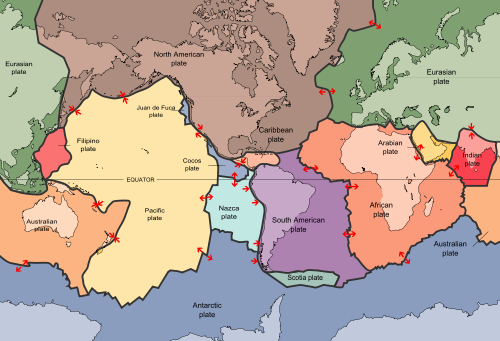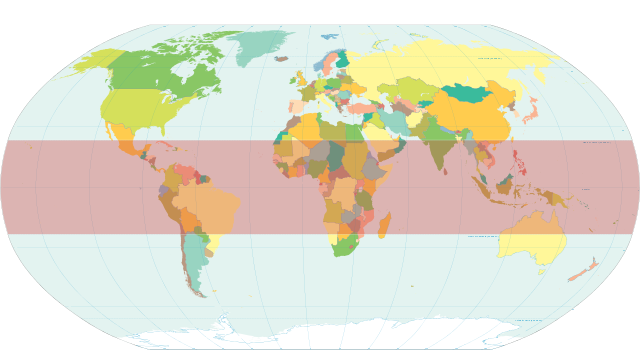Biogeography Terms
Get down with the lingo
Abiotic
Non-living. Rocks, wind and smoke are not living, despite what you may have seen on Lost.Adaptive Radiation
The rapid evolution of new species descended from one ancestor. Adaptive radiations let organisms fulfill different ecological roles in the same area.Biogeography
The geographic distribution of species. Biogeography takes into account the history of climate and movement of land masses to explain why organisms live where they do.Biome
Any of the Earth's major habitats. These include tropical rainforests, tundra, deserts and temperate grasslands.Biota
Living things. Anything that is living is "biotic" and anything non-living, such as rocks, is "abiotic." We can talk about biota in general, but when people use the term "biota" they usually are talking about the living things in a particular area, such as desert biota or rainforest biota. As far as we know, the biota of Mars is non-existent.Climate
Long-term patterns of temperature and precipitation. While you may have heard of the "political climate," here we are just talking about things that happen in the atmosphere. Climate is different than weather. Weather refers to short-term events, like ,"It's raining today." Climate refers to weather patterns over many years, like nine feet of rainfall each year in the Amazon rainforest.Coriolis Effect
The deflection of winds at the equator. As the Earth turns to the east, the path of air (or water) moving toward the equator curves west. This is because any point at the equator is moving faster than a point further north or south in the Earth's rotation. Watch this video for a demonstration.Cosmopolitan
Occurring everywhere. Although this word has many meanings (the drink, the magazine, the hotel in Las Vegas), in biogeography it refers to where a species or genus lives.Desert
An arid land where no man ought go lest he fall prey to the beasts of the wild…Oh sorry. You wanted a definition? Deserts are one of the Earth's major habitats (or biomes), covering about a third of the planet's landmass. They receive less than ten inches of rainfall a year, but can be sandy, rocky, cold, or hot.Disjunct Distribution
A geographic range of closely related organisms that is not continuous. If half of the species in a genus live in South America, and the other half live in Africa, then that genus has a disjunct distribution.Dispersal
An organism's way of getting around. Usually they don't take a train or taxi, but have some sort of method that lets them or their babies move. If you have a dog or cat, you have probably had to pull burrs out of their tail at some point. Burrs are plant seeds with little hooks that let them attach to animals' fur and reach a new area. Animals typically walk, swim, or fly, but plants have other devices for getting around.Distribution
Where a species lives, geographically speaking. The distribution of humans is the whole Earth except for Antarctica, and the distribution of koalas is Australia.Equator
The horizontal belt that wraps around the Earth halfway between the North and South Poles. The equator is 0° latitude.Endemic
Occurring only in one place. Pandas are endemic to China—they only live there. Pandas can also be found chomping bamboo in zoos, but they came from China and only naturally occur there.
Awwww everybody loves pandas. Image from here.
Evapotranspiration
The evaporation of water from plants and the soil. This word is a combination of evaporation (from soil) and transpiration, which is just water loss from a living organism.Gondwana
The southern part of the giant land mass that the continents formed 135 million years ago. Gondwana was made up of what is now South America, Africa, Australia, and Antarctica.Habitat
An area that is the natural home for an organism. Habitats are usually defined by climate but can also be defined by creatures that live there. For example, coral reefs are home to lots of fish, sponges, anemones, and other animals, but are defined by the coral (which is an animal, FYI) that creates them. Mangroves are trees but also define the swampy habitats they live in.Hadley Cell
An air circulation pattern where warm air rises above the equator, loses its moisture as rain, then falls back down in the atmosphere at 30° latitude.Latitude
Distance from the equator, measured in degrees. Latitude starts at 0º at the equator and goes to 90º at the poles; latitudes in the northern hemisphere are denoted with N, and latitudes in the southern hemisphere have an S.Laurasia
The northern part of the giant landmass that formed 135 million years ago. Laurasia was made up of what is now North America, Europe, and most of Asia.Marine
Anything having to do with the ocean. A marine species lives in the ocean, but "aquatic" usually means freshwater.Pangaea
The giant supercontinent made up of all of the continents. Pangaea existed about 250 million years ago, at the end of the Paleozoic era. We know from fossil evidence that the continents were once all joined together because the distributions of organisms only makes sense if the land was connected, like this map shows:
Pelagic
The open sea. The ocean is divided into zones based on depth and distance from shore. The pelagic zone is far from shore, which makes water clearer. This allows sunlight to penetrate deeper into the pelagic zone than the coastal zone. Not 20,000 leagues deep, but deep enough for a lot of plankton to be very happy.Plate Tectonics
he theory that Earth's crust is made up of distinct sections that move and run into each other. Plate tectonics explains why continents move through time, why earthquakes happen, and how mountain ranges form. Unfortunately, it does not explain Bigfoot. Plate tectonics builds on the idea of continental drift that was around for a long time, but was not accepted as a theory until the 1970s.Range
The geographical area an organism lives in. The range is the extent of land (or water) that a species occupies. Species periodically expand their ranges, just naturally or because of changes in habitat and climate. Before 1850, the Rio Grande was the northern range limit for armadillos. Since then, armadillos have moved further north into the US, but no one knows why. Many species ranges are expected to shift because of climate change.Terrestrial
Living on land. While extraterrestrials come from outer space and invade Katy Perry music videos with their spaceships, terrestrial organisms stay grounded on land.Tropics
We know what you're thinking. The tropics mean beaches, palm trees, and bikinis, not much else to know. Right? Not so fast. Although beaches, coconuts, and bikinis are great reasons to love the tropics, we're getting all formal-definition on you. The definition is not "somewhere south of the equator." The tropics is an area defined between the Tropic of Cancer at 23.5 degrees north of the equator and the Tropic of Capricorn at 23.5 degrees south of the equator. This area is called the tropics on any planet, not just Earth. Mars and Venus have tropics, too, they just don't have the same beaches and we're pretty sure there are no palm trees or bikinis there, either.
The tropics are highlighted in red on this map.